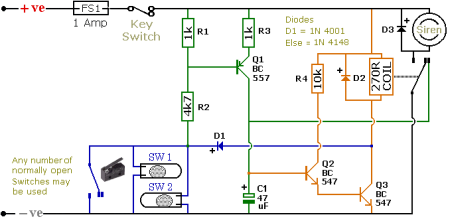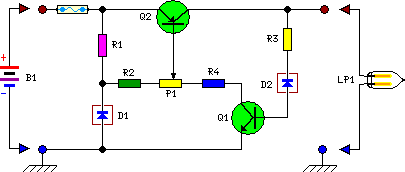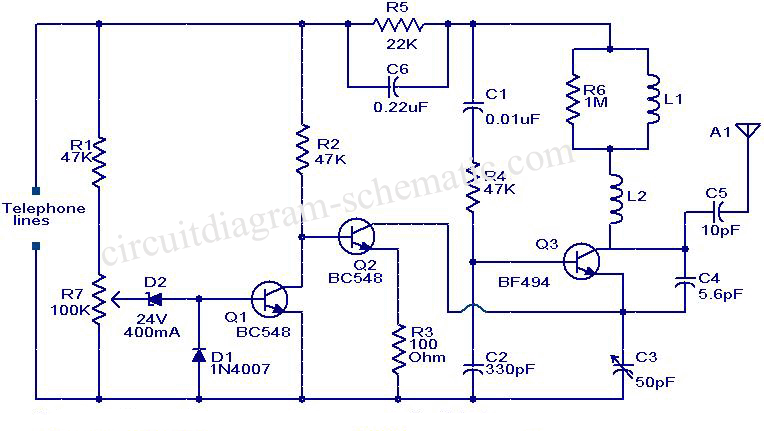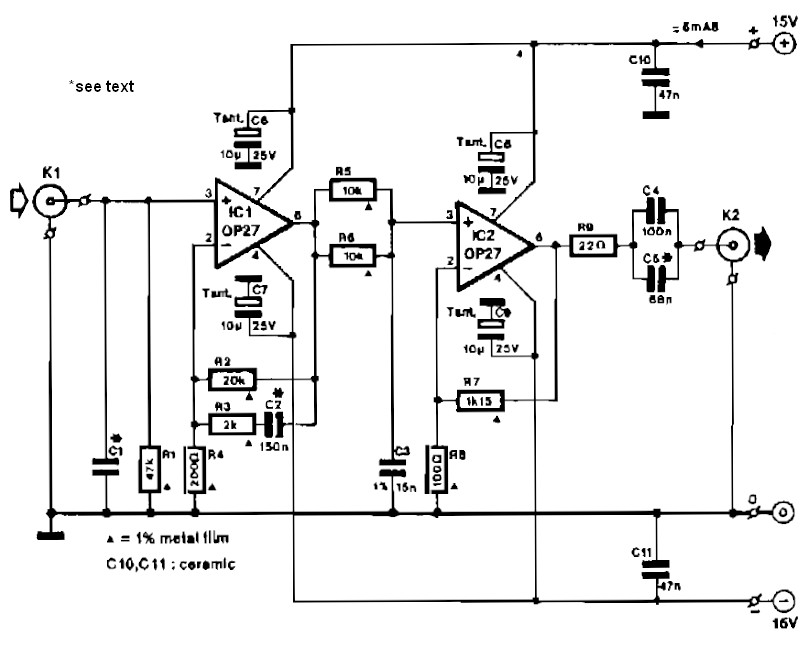
simple sound to light converter schematic
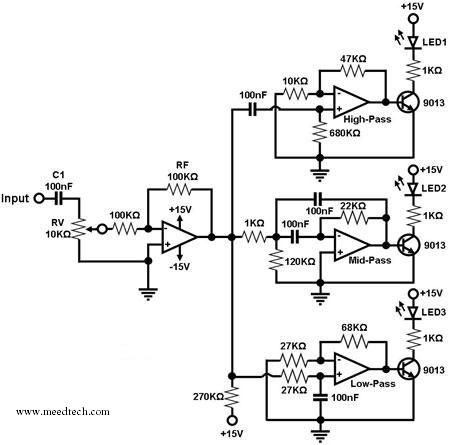
A simple circuit for converting an audio signal (such as one that comes from the output terminals of a CD player). The circuit basically consists of a buffer/amplifier stage and three filter circuits: a high-pass filter, a mid-pass filter, and a low-pass filter. The output of each filter drives a light-emitting diode of different color. The input signal is fed to the buffer stage through capacitor C1. The values of resistors RF and RV1 should be selected so that the buffer can drive the three filters connected to its output. The low-frequency, mid-frequency, and high-frequency components of the input signal are allowed to pass through the low-pass filter (bottom filter), the mid-pass filter (middle filter), and the high-pass filter (topmost filter), respectively, effectively separating them from each other. Changes in the output of a filter cause its corresponding output LED to turn on and off. Consequently, applying a continuous audio signal to the input of this circuit causes the LEDs to flicker.
The described circuit serves as an audio signal visualizer, where the audio input is processed through a series of filters that segregate different frequency ranges. The buffer/amplifier stage ensures that the input signal is adequately amplified and buffered to prevent loading effects that could distort the signal. Capacitor C1 acts as a coupling capacitor, allowing AC signals to pass while blocking any DC component, thereby preserving the integrity of the audio signal.
The three filter circuits are designed to isolate specific frequency bands: the low-pass filter allows frequencies below a certain cutoff to pass, the mid-pass filter permits a range of frequencies around a designated center frequency, and the high-pass filter enables frequencies above a certain threshold to pass. Each filter's output is connected to a light-emitting diode (LED) that visually represents the presence of audio energy within its designated frequency range. The choice of resistor values RF and RV1 is critical, as they define the gain of the buffer and the overall response of the filters.
When audio input is received, the circuit responds dynamically; as the amplitude of different frequency components varies, the corresponding LEDs illuminate or extinguish, providing a visual representation of the audio spectrum. This functionality makes the circuit useful for audio analysis, music visualizations, or as a decorative element in audio equipment. The design can be further enhanced by adjusting the filter characteristics or adding more frequency bands for a more detailed visual output.A simple ambit for converting an audio arresting (such as one that comes from the apostle terminals of a CD player). The ambit basically consists of a buffer/amplifier date and three clarify circuits: a high-pass filter, a mid-pass filter, and a low-pass filter.
The achievement of anniversary clarify ambit drives a light-emitting di ode of altered color. The ascribe arresting is fed to the absorber date through C1. The ethics of RF and RV1 should be called so that the absorber is able to drive the three filters absorbed to its output. The low-frequency, mid-frequency, and high-frequency apparatus of the ascribe arresting are alone accustomed to canyon through the low-pass clarify (bottom filter), the mid-pass clarify (middle filter), and the high-pass clarify (topmost filter), respectively, appropriately amid them from anniversary other.
Changes in the achievement of a clarify account its agnate achievement LED to about-face on and off. In effect, agriculture a connected audio arresting to the ascribe of this ambit causes the LED`s to dance`. 🔗 External reference
The described circuit serves as an audio signal visualizer, where the audio input is processed through a series of filters that segregate different frequency ranges. The buffer/amplifier stage ensures that the input signal is adequately amplified and buffered to prevent loading effects that could distort the signal. Capacitor C1 acts as a coupling capacitor, allowing AC signals to pass while blocking any DC component, thereby preserving the integrity of the audio signal.
The three filter circuits are designed to isolate specific frequency bands: the low-pass filter allows frequencies below a certain cutoff to pass, the mid-pass filter permits a range of frequencies around a designated center frequency, and the high-pass filter enables frequencies above a certain threshold to pass. Each filter's output is connected to a light-emitting diode (LED) that visually represents the presence of audio energy within its designated frequency range. The choice of resistor values RF and RV1 is critical, as they define the gain of the buffer and the overall response of the filters.
When audio input is received, the circuit responds dynamically; as the amplitude of different frequency components varies, the corresponding LEDs illuminate or extinguish, providing a visual representation of the audio spectrum. This functionality makes the circuit useful for audio analysis, music visualizations, or as a decorative element in audio equipment. The design can be further enhanced by adjusting the filter characteristics or adding more frequency bands for a more detailed visual output.A simple ambit for converting an audio arresting (such as one that comes from the apostle terminals of a CD player). The ambit basically consists of a buffer/amplifier date and three clarify circuits: a high-pass filter, a mid-pass filter, and a low-pass filter.
The achievement of anniversary clarify ambit drives a light-emitting di ode of altered color. The ascribe arresting is fed to the absorber date through C1. The ethics of RF and RV1 should be called so that the absorber is able to drive the three filters absorbed to its output. The low-frequency, mid-frequency, and high-frequency apparatus of the ascribe arresting are alone accustomed to canyon through the low-pass clarify (bottom filter), the mid-pass clarify (middle filter), and the high-pass clarify (topmost filter), respectively, appropriately amid them from anniversary other.
Changes in the achievement of a clarify account its agnate achievement LED to about-face on and off. In effect, agriculture a connected audio arresting to the ascribe of this ambit causes the LED`s to dance`. 🔗 External reference
